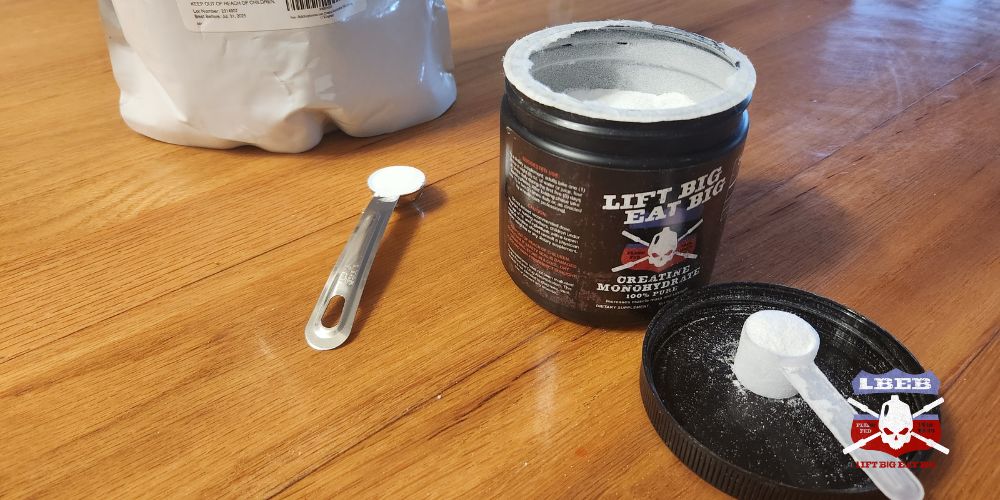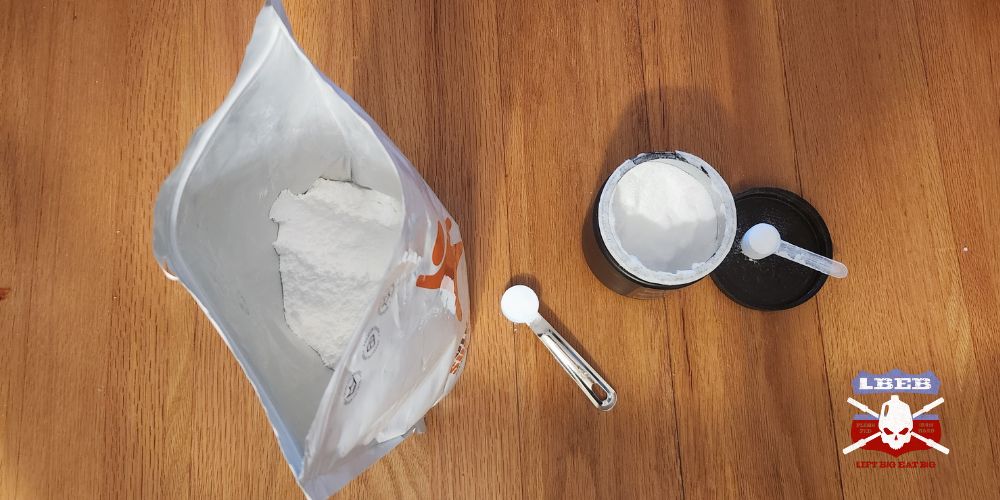Since the early 1990s, creatine monohydrate powder has been the most extensively researched and widely employed form of creatine in dietary supplements. However, over the past couple of years, other forms of creatine, like the creatine salt HCl, have become popular. When it comes to creatine HCl vs monohydrate, which is better?
Only a limited number of studies currently exist directly comparing the effectiveness of creatine HCl versus monohydrate. There is not enough evidence showing that creatine HCl is better than monohydrate, and claims that creatine HCl does not need a loading period or leads to less bloating or gut issues are not supported by the literature.
While marketing can make new forms of creatine, like creatine HCl, seem enticing, it’s important to look at the available evidence to see if it is worth choosing.
Table of Contents
What Is Creatine Monohydrate?
Creatine monohydrate is the simplest form of creatine found in the human body, formed by 3 amino acids: glycine, arginine, and methionine [1].
Creatine is also found in food sources like meat, and most of the body’s creatine (95%) is stored in the skeletal muscles, while about 5% is found in the brain, liver, kidney, and testes [2].
What Is Creatine HCl?
Creatine HCl is made by adding a hydrochloride group to creatine monohydrate. This hydrochloride is similar to what is found in stomach acid. Manufacturers claim that this addition improves creatine’s stability and ability to dissolve, which should help with absorption.
Creatine HCL vs. Monohydrate Similarities & Differences

Both creatine HCl and creatine monohydrate have the potential to improve performance by increasing muscle creatine stores [2]. They are also classified as non-banned substances and can be used in competition [2,3].
Compared with creatine monohydrate, creatine HCl is 41 times more soluble in water [4]. However, more research is needed to confirm if creatine hydrochloride is, in fact, more bio-available than creatine monohydrate[5, 6]. “Bio-availability” refers to both the body’s ability to absorb a substance and the ability of the body’s cells and tissues to use it.
Creatine monohydrate powder is stable and doesn’t show signs of degradation, even at high temperatures. On the other hand, creatine salts like creatine HCl are less stable at high temperatures [7].
Dose And Efficacy
Because creatine HCl has a higher solubility when compared to creatine monohydrate, it is often marketed that a lower dosage is needed to achieve the same results as creatine monohydrate. Some claim that a loading protocol is not required when taking creatine HCl.
However, there has not been enough research on creatine HCl to conclude these claims, and current marketing claiming these advantages of creatine HCl is misleading [6, 7].
There also needs to be more studies done on creatine HCl to make specific recommendations on effective and safe dosages for loading and maintenance [6, 7].
In a study done on 36 resistance training men, participants were divided into four groups: Group 1 took 20g of creatine monohydrate (loading dose), group 2 took 3g of creatine monohydrate (maintenance dose), group 3 took 3g of creatine HCl and group 4 took a placebo. All groups took their supplements for a week [8].
No differences were found between the creatine monohydrate and creatine HCl groups when looking at performance outcomes, which means that, at best, creatine HCl will have similar results to creatine monohydrate.
Benefits
Supplement companies claim that creatine HCl does not require a loading phase, cycling, or water retention and reduces gut issues and bloating that may occur when doing a creatine load.
However, research found that there seems to be no positive effects on physical performance and hormonal status in athletes without a loading period of one week [8].
Creatine monohydrate does not cause water retention beyond the loading period [3], and there is no evidence of water retention when using creatine HCl.
Bloating

Some athletes report feeling bloated after the creatine monohydrate loading phase of 20g per day due to water retention [9]. This will be a short-term response because water retention generally only occurs during the loading period [10].
Additionally, it has been shown that the risk of gastrointestinal issues may be increased when taking 10g of creatine or more at once [11].
There is insufficient evidence to conclude that creatine HCl will lead to less bloating than creatine monohydrate.
If you struggle with discomfort due to bloating, having creatine monohydrate at lower doses may be an alternative.
Because bloating usually occurs during the loading period, opting only to do a maintenance protocol (3 – 5g per day) will still yield performance and body composition benefits. However, it may take longer to achieve saturation of your muscle creatine stores.
Side Effects and Safety
Although it seems as though creatine HCl may have less gastrointestinal side effects like bloating, there is not enough research to substantiate this claim.
Numerous studies have been published on the side effects and safety of creatine monohydrate at recommended dosages [3, 7]. Side effects, like initial water retention during the loading phase, are minimal.
Creatine monohydrate does not lead to dehydration or electrolyte imbalances[3, 7], cause gastrointestinal issues when taken at recommended dosages [3, 7], and weight gain associated with creatine use is associated with increased muscle mass.
Creatine monohydrate has been shown to be safe in various populations, including teens [3, 7].
The research on the side effects and safety of creatine HCl is sparse and insufficient to conclude the short- and long-term effects of taking it. There is also not enough research to recommend optimal or safe dosages of creatine HCl.
Is Creatine HCL Or Monohydrate Better?
At present, there exists only a limited number of studies directly comparing the effectiveness of creatine HCl versus monohydrate.
Generally, when similar doses of creatine monohydrate and creatine HCl are used, no notable disparities in outcome measures (such as increased muscle mass or strength) are observed.
Because most of the research on creatine has been done using creatine monohydrate, much more information is available on optimal dosages and safety in various populations.
Ongoing research will reveal innovative creatine variants’ potential benefits and drawbacks, such as creatine HCl. For now, starting with creatine monohydrate is advisable before exploring the more unconventional choices.
Summary
Creatine monohydrate supplementation consistently boosts muscle energy stores, enhances performance in repeated high-intensity exercises, and supports better training results.
It’s a robust form of creatine that remains largely intact during digestion, either getting absorbed by muscles or excreted in urine. Despite its widespread global use, there haven’t been any significant reported health issues.
On the other hand, the effectiveness, safety, and regulatory status of most newer creatine forms in dietary supplements aren’t well confirmed.
Furthermore, there’s little to no evidence backing up claims in marketing that these newer creatine forms are more stable, digested faster, and more efficient in increasing muscle creatine levels or associated with fewer side effects compared to creatine monohydrate.
Due to the lack of evidence of the superiority of creatine HCl vs. creatine monohydrate, it is better to opt for the widely researched creatine monohydrate if you want to improve performance.
References
- da Silva, R. P., Nissim, I., Brosnan, M. E., & Brosnan, J. T. (2009). Creatine synthesis: hepatic metabolism of guanidinoacetate and creatine in the rat in vitro and in vivo. American Journal of Physiology. Endocrinology and Metabolism, 296(2), E256–E261. https://doi.org/10.1152/ajpendo.90547.2008
- Kreider, R. B., Kalman, D. S., Antonio, J., et al. (2017). International Society of Sports Nutrition position stand: safety and efficacy of creatine supplementation in exercise, sport, and medicine. Journal of the International Society of Sports Nutrition, 14, 18. https://doi.org/10.1186/s12970-017-0173-z
- Antonio, J., Candow, D. G., Forbes, S. C., Gualano, B., Jagim, A. R., Kreider, R. B., Rawson, E. S., Smith-Ryan, A. E., VanDusseldorp, T. A., Willoughby, D. S., & Ziegenfuss, T. N. (2021). Common questions and misconceptions about creatine supplementation: What does the scientific evidence really show? Journal of the International Society of Sports Nutrition, 18(1), 13. https://doi.org/10.1186/s12970-021-00412-w
- Gufford, B. T., Sriraghavan, K., Miller, N. J., Miller, D. W., Gu, X., Vennerstrom, J. L., & Robinson, D. (2010). Physicochemical Characterization of Creatine N-Methylguanidinium Salts. Journal of Dietary Supplements, 7, 240-252.
- Alraddadi, E. A., Lillico, R., Vennerstrom, J. L., Lakowski, T. M., & Miller, D. W. (2018). Absolute Oral Bioavailability of Creatine Monohydrate in Rats: Debunking a Myth. Pharmaceutics, 10(1), 31. https://doi.org/10.3390/pharmaceutics10010031
- Jäger, R., Purpura, M., Shao, A., Inoue, T., & Kreider, R. B. (2011). Analysis of the efficacy, safety, and regulatory status of novel forms of creatine. Amino Acids, 40(5), 1369–1383. https://doi.org/10.1007/s00726-011-0874-6
- Kreider, R. B., Kalman, D. S., Antonio, J., Ziegenfuss, T. N., Wildman, R., Collins, R., Candow, D. G., Kleiner, S. M., Almada, A. L., & Lopez, H. L. (2017). International Society of Sports Nutrition position stand: safety and efficacy of creatine supplementation in exercise, sport, and medicine. Journal of the International Society of Sports Nutrition, 14, 18. https://doi.org/10.1186/s12970-017-0173-z
- Escalante G, Gonzalez AM, St Mart D, Torres M, Echols J, Islas M, Schoenfeld BJ. Analysis of the efficacy, safety, and cost of alternative forms of creatine available for purchase on Amazon.com: are label claims supported by science? Heliyon. 2022 Dec 6;8(12):e12113. doi: 10.1016/j.heliyon.2022.e12113. PMID: 36544833; PMCID: PMC9761713.
- Greenwood, M., Farris, J., Kreider, R., Greenwood, L., & Byars, A. (2000). Creatine supplementation patterns and perceived effects in select Division I collegiate athletes. Clinical Journal of Sport Medicine, 10, 191–194. doi: 10.1097/00042752-200007000-00007.
- Dalbo, V. J., Roberts, M. D., Stout, J. R., & Kerksick, C. M. (2008). Putting to rest the myth of creatine supplementation leading to muscle cramps and dehydration. British Journal of Sports Medicine, 42, 567–573. doi: 10.1136/bjsm.2007.042473
- Ostojic, S. M., & Ahmetovic, Z. (2008). Gastrointestinal distress after creatine supplementation in athletes: Are side effects dose dependent? Research in Sports Medicine (Print), 16(1), 15–22. https://doi.org/10.1080/15438620701693280
